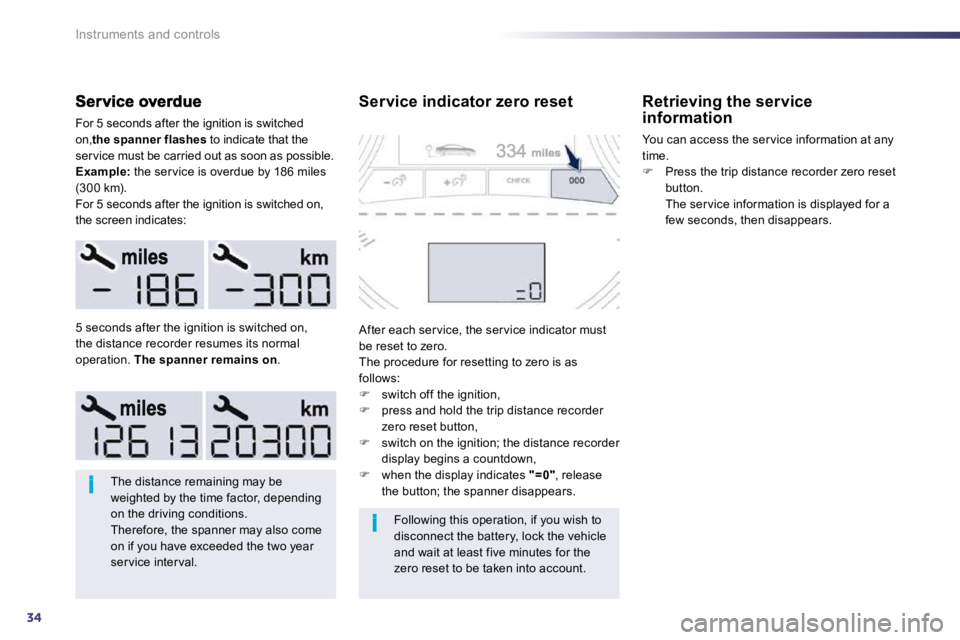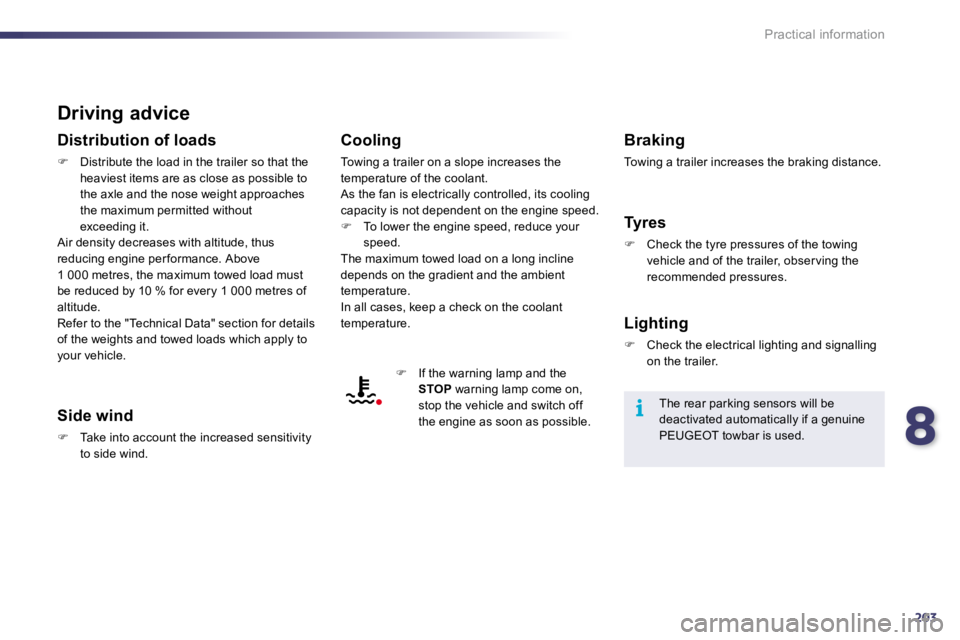Page 34 of 330

34
i
i
Instruments and controls
For 5 seconds after the ignition is switched on, the spanner flashes to indicate that the service must be carried out as soon as possible. Example: the ser vice is overdue by 186 miles (300 km). For 5 seconds after the ignition is switched on, the screen indicates:
The distance remaining may be weighted by the time factor, depending on the driving conditions. Therefore, the spanner may also come on if you have exceeded the two year ser vice inter val.
Following this operation, if you wish to disconnect the battery, lock the vehicle and wait at least five minutes for the zero reset to be taken into account.
5 seconds after the ignition is switched on, the distance recorder resumes its normal operation. The spanner remains on .
Service indicator zero reset
After each ser vice, the ser vice indicator must be reset to zero. The procedure for resetting to zero is as follows: � switch off the ignition, � press and hold the trip distance recorder zero reset button,
� switch on the ignition; the distance recorder display begins a countdown,
� when the display indicates "=0" , release the button; the spanner disappears.
Retrieving the service information
You can access the ser vice information at any time. � Press the trip distance recorder zero reset button. The ser vice information is displayed for a few seconds, then disappears.
Page 159 of 330
146
i
Child safety
General points relating to child seats
following recommendations: - in accordance with European regulations, all children under the age of 12 or less than one and a half metres tall must travel in approved child seats suited to their weight , on seats fitted with a seat belt or ISOFIX mountings * , - statistically, the safest seats in your vehicle for carr ying children are the rear seats, - a child weighing less than 9 kg must travel in the "rear wards-facing" position both in the front and in the rear.
PEUGEOT recommends that children should travel in the rear seats of your vehicle: - "rearwards-facing" up to the age of 2, - "forwards-facing" over the age of 2.
Although one of PEUGEOT's main criteria when designing your vehicle, the safety of your children also depends on you.
* The rules for carrying children are specific to each country. Refer to the current legislation in your country.
Page 162 of 330
6149
./..
Child safety
Installing child seats attached using the seat belt
In accordance with European regulations, this table indicates the options for installing child seats secur ed using a seat belt and universally approved (a) in accordance with the weight of the child and the seat in the vehicle.
Weight of the child and indicative age
SeatUnder 13 kg(groups 0 ( b ) and 0+) Up to approx 1 year
From 9 to 18 kg(group 1) 1 to 3 years approx
From 15 to 25 kg(group 2) 3 to 6 years approx
From 22 to 36 kg(group 3) 6 to 10 years approx
Front passenger seat ( c )with height adjuster U (R)U (R)U (R)U (R)
Front passenger seat (c)without height adjuster UUUU
Saloon
Outer rear seats UUUU
Centre rear seat XXXX
SW
Outer rear seats UUUU
Centre rear seat XXXX
Page 163 of 330
150
Child safety
a: universal child seat, child seat that can be installed in all vehicles using a seat belt. b: group 0, from bir th to 10 kg. Shells seats and baby c arriers cannot be installed in the front passenger seat. c: consult the legislation in force in your country before installing your child on this seat. U: seat suitable for the installation of a child seat secured using a seat belt and universally approved, "rear wards-facing" and/or "for wards-facing". U (R): idem U , with the vehicle's seat adjusted to the highest position and as far back as possible. X: seat position not suitable for installation of a child seat for the weight class indicated.
Page 167 of 330
154
Child safety
Locations for installing ISOFIX child seats
In accordance with European Regulations, this table indicates the options for installing ISOFIX child sea ts on seats in the vehicle fitted with ISOFIX mountings. In the case of universal and semi-universal ISOFIX child seats, the ISOFIX size category, determined by a letter from A to G , is indicated on the child seat next to the ISOFIX logo.
Weight of the child /indicative age
Less than 10 kg (group 0)Up to approx. 6 months
Less than 10 kg(group 0) Less than 13 kg(group 0+)Up to approx. 1 year
From 9 to 18 kg (group 1)From approx. 1 to 3 years
Type of ISOFIX child seatShell"rear wards-facing""rearwards-facing""for wards-facing"
ISOFIX size categor yFGCDECDABB1
Front passenger seat Not Isofix
Saloon
Outer rear seats XIL- SUIL- SUIUF
IL- SU
Centre rear seat Not Isofix
SW
Outer rear seats XIL- SUIL- SUIUFIL- SU
Centre rear seat Not Isofix
Page 168 of 330
6155
Child safety
IUF: seat suitable for the installation of an I sofix U niversal seat, " F or wards-facing" secured using the top belt. IL- SU: seat suitable for the installation of an I sofix S emi- U niversal seat either: - "rear wards-facing" fitted with a top belt or a s tay, - "for wards-facing" fitted with a stay, - a shell seat fitted with an upper strap or a stay . For advice on securing of the top belt, refer to the paragraph "Isofix mountings".
X: seat not suitable for the installation of a child seat or shell for the weight group indicated.
Page 220 of 330

8203
i
Practical information
Driving advice
Distribution of loads
� Distribute the load in the trailer so that the heaviest items are as close as possible to the axle and the nose weight approaches the maximum permitted without exceeding it. Air density decreases with altitude, thus reducing engine per formance. Above 1 000 metres, the maximum towed load must be reduced by 10 % for every 1 000 metres of altitude. Refer to the "Technical Data" section for details of the weights and towed loads which apply to your vehicle.
Side wind
� Take into account the increased sensitivity to side wind.
Cooling
Towing a trailer on a slope increases the temperature of the coolant. As the fan is electrically controlled, its cooling capacity is not dependent on the engine speed. � To lower the engine speed, reduce your speed. The maximum towed load on a long incline depends on the gradient and the ambient temperature. In all cases, keep a check on the coolant temperature.
� If the warning lamp and the STOP warning lamp come on, stop the vehicle and switch off the engine as soon as possible.
Braking
Towing a trailer increases the braking distance.
Tyres
� Check the tyre pressures of the towing vehicle and of the trailer, obser ving the recommended pressures.
Lighting
� Check the electrical lighting and signalling on the trailer.
The rear parking sensors will be deactivated automatically if a genuine PEUGEOT towbar is used.
Page 221 of 330
204
i
!
Practical information
Fitting roof bars
Maximum authorised weight on the roof rack, for a loading height not exceeding 40 cm (with the exception of bicycle carriers): - Saloon: 70 kg - SW: 100 kg If the height exceeds 40 cm, adapt the speed of the vehicle to the profile of the road to avoid damaging the roof bars and the fixings on the roof. Be sure to refer to national legislation in order to comply with the regulations for transpor ting objects which are longer than the vehicle.
- Saloon: there are retaining pins in the door
aper tures.
When fitting transverse roof bars, take care to position them correctly:
- SW: there are markings on each of the
longitudinal bars.
Use accessories recommended by PEUGEOT obser ving the
manufacturer's recommendations and fitting instructions so as to avoid the risk of damaging the body (deformation, scratches, ...).